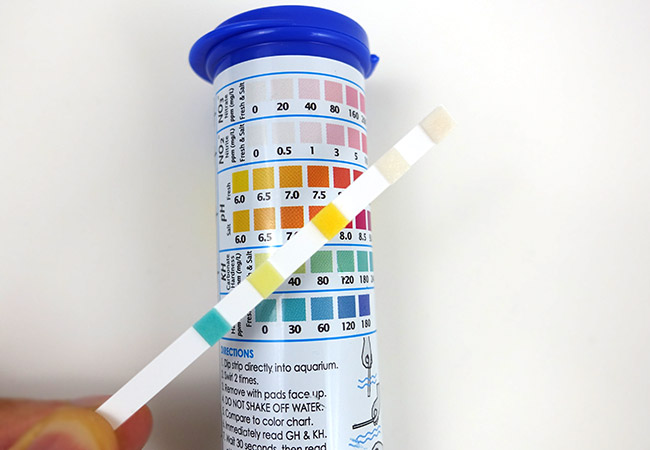Aquarium Test Strip Chart
Aquarium test strip chart is an important tool for fish keepers to ensure their aquarium water is safe and healthy for their fish. However, many aquarium owners find it confusing to read and interpret the results from the chart. In this article, we will discuss everything you need to know about aquarium test strip chart and how to use it effectively.
The Pain Points of Aquarium Test Strip Chart
Many aquarium owners find it difficult to read and interpret the results from the aquarium test strip chart. It can be confusing to determine which color corresponds to which chemical parameter. Additionally, inaccurate readings can lead to improper treatment of the aquarium water, which can be harmful to fish. Moreover, some aquarium owners may not be aware of the importance of regular water testing, leading to neglect and potential health issues for their fish.
What is the Target of Aquarium Test Strip Chart?
The target of an aquarium test strip chart is to check the levels of various chemical parameters in the aquarium water, such as pH, ammonia, nitrite, and nitrate. By regularly testing the water, aquarium owners can ensure that the levels are within a safe range for their fish to thrive, and take corrective measures if necessary.
Summary
In summary, aquarium test strip chart is an essential tool for maintaining healthy aquariums. However, it is important to use it correctly and interpret the results accurately to prevent harm to fish. Regular water testing should be a part of every aquarium owner's maintenance routine to ensure a safe and healthy environment for their fish.
Aquarium Test Strip Chart: How to Use it Effectively
As an aquarium owner, you have probably come across an aquarium test strip chart at one point or another. These charts are a quick and easy method to test the water quality of your aquarium. To use the chart, follow these simple steps:
Step 1: Dip the strip into the aquarium water for a few seconds and then remove it.

Step 2: Compare the colors on the test strip to the chart on the packaging.
Step 3: Acquire the necessary chemicals to correct any imbalances in the levels of chemical parameters found in the aquarium water.
It is important to note that aquarium test strip charts provide a general range for the levels of various chemical parameters and are not 100% accurate. To get the most accurate readings, use a liquid test kit in conjunction with the test strip chart.
How to Choose the Right Aquarium Test Strip Chart
When choosing an aquarium test strip chart, it is essential to select one that tests for all the necessary chemical parameters. Additionally, make sure the chart is easy to read and interpret. High-quality charts will provide clear and concise instructions, accurate results, and a color chart that is easy to compare.
Interpreting the Results
Interpreting the results from an aquarium test strip chart can be confusing, as different brands may use different color codes. However, regardless of the chart's color codes, it is essential to keep the levels of chemical parameters within a safe range for your fish. For example, ammonia levels should be at zero, while nitrite and nitrate levels should be minimal.
Take Corrective Measures
If the results of a test strip show that the levels of chemical parameters in the aquarium are out of range, corrective measures need to be taken. A chemical imbalance can lead to sick fish or even death. Some potential corrective measures include water changes, the addition of chemicals to the aquarium water, and removal of waste and debris.
Question and Answer Section
Q: How often should I test the water in my aquarium?
A: You should test the water in your aquarium at least once a week, especially if you have a new aquarium or have recently added new fish.
Q: How do I know if the aquarium test strip chart is accurate?
A: You can double-check the accuracy of the test strip chart by using a liquid test kit. If the results from both tests align, you can be confident that the chart is accurate.
Q: What should I do if the results from the test strip show unsafe levels of chemical parameters?
A: If the results from the test strip show unsafe levels of chemical parameters, you should take corrective measures immediately, such as performing a water change or adding chemicals to the water.
Q: Can I reuse a test strip?
A: No, test strips are designed for one-time use only, and reusing them can lead to inaccurate results.
Conclusion
Aquarium test strip chart is a simple and effective way to test the water quality of your aquarium. By using it correctly, interpreting the results accurately, and taking corrective measures if necessary, you can create a safe and healthy environment for your fish to thrive.
Gallery
API 5 IN 1 Aquarium Tank Test Strip KIT PH Nitrite Nitrate Carbonate
Photo Credit by: bing.com / nitrate nitrite carbonate molyacuarium 4pc dip
The Beginner’s Guide To Aquarium Test Strips – And, Why They Suck

Photo Credit by: bing.com / test aquarium strips chart color strip guide results suck beginner why they step check
Pin On Aquarium

Photo Credit by: bing.com / aquarium strips water testing guide fish tank freshwater distilled
Pin By Jessica Thomas On Garden | Fresh Water, Fish Chart, Chart

Photo Credit by: bing.com / freshwater plantedtank
Freshwater Frenzy: How To Read Aquarium Water Test Strips

Photo Credit by: bing.com / freshwater test strips aquarium water read fish frenzy
